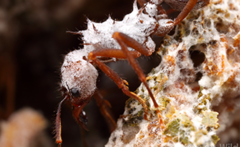Integrative taxonomy solves a centuries-old question about the diversity of leaf-cutting ants [28.04.25]
Integrative taxonomy as the basis for suitable measures for recognizing and delimiting species

Photo: Alex Wild / alexanderwild.com.
Acromyrmex is a genus of leaf-cutting ants that plays an important and biologically interesting role in neotropical ecosystems. Leaf-cutting ants do not eat the harvested leaves, but use them to fertilise a fungus garden, which they grow in underground chambers to feed their larvae. This way of life has fascinated biologists for centuries. Unfortunately, species identification is extremely difficult, as the diversity and systematic classification of the Acromyrmex genus has never been recorded in a modern, integrative research approach.
Daniela Mera-Rodríguez, a doctoral student in the KomBioTa research group Integrative Taxonomy and Biodiversity of Insects led by Prof Christian Rabeling, analysed the Acromyrmex octospinosus species group in her latest study and was able to draw new conclusions about its biodiversity.
This genus is widespread in Central and South America and was discovered 232 years ago by Gottfried Christian Reich. In the following 150 years, ants were collected in Central and South America and sent to European and North American entomologists for identification. These entomologists gave new taxonomic names to the variety of shapes and colors of the leaf-cutting ants, which led to a diversity of names in museums that far exceeded the biological diversity of species.
Modern research wants to correctly record the biodiversity of our planet and is therefore working on a comparison of the historical diversity of names with the actual biological diversity. To this end, modern methods such as gene sequencing and family tree analyses are combined with traditional approaches such as morphometrics and taxonomy. Daniela Mera-Rodríguez has now been able to compare the different species, subspecies and diverse forms of different populations with each other and prove that the historical species and subspecies within the Acromyrmex octospinosus species group all belong to just two biological species: Acromyrmex octospinosus and the social parasite Acromyrmex insinuator.
This discovery changes our understanding of the biodiversity of Acromyrmex leaf-cutting ants and is an important step towards a complete taxonomic record of this ant genus.
Daniela Mera-Rodríguez gave further insights into her scientific work in an interview published on the entomology blog https://blog.myrmecologicalnews.org.
Publication
Daniela Mera-Rodríguez, Hermógenes Fernández-Marín, Christian Rabeling (2024): Phylogenomic approach to integrative taxonomy resolves a century-old taxonomic puzzle and the evolutionary history of the Acromyrmex octospinosus species complex. Systematic Entomology, 1–26.
https://doi.org/10.1111/syen.12665
Back to Latest News